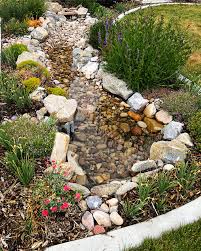A dry creek bed is an excellent addition to any garden, blending beauty with function. Not only does it enhance the visual appeal of your outdoor space, but it also improves drainage and helps prevent soil erosion. Below is a comprehensive guide to creating a dry creek bed, from planning to maintenance.
Step 1: Planning Your Dry Creek Bed
1.1. Select the Right Location
Start by assessing your garden. The best spots for a dry creek bed are naturally low areas or places where water tends to accumulate. You can also place one in areas where you want to redirect excess water away from plants or structures.
1.2. Design the Layout
Sketch a rough design on paper. A dry creek bed should follow gentle, curving lines to mimic the flow of a natural stream. Vary the width along its path for a more organic look.
1.3. Check Local Regulations
Before you begin, verify any local regulations regarding landscape alterations or water redirection, as some areas may require permits.
Step 2: Marking and Digging the Bed
2.1. Mark the Creek Bed Outline
Using landscape paint or a garden hose, mark the outline of the creek bed on the ground. This will give you a visual representation of the shape.
2.2. Digging the Bed
Dig along the marked lines. For a small creek, a 2-3 inch depth is sufficient, while larger sections may require up to 6 inches. Gradually slope the sides for a natural appearance.
2.3. Create a Gradient
If your yard is flat, make sure the creek bed slopes slightly (around 1-2%) to direct the flow of water. This ensures proper drainage, even in areas with little natural incline.

Step 3: Preparing the Foundation
3.1. Lay Landscape Fabric
Place landscape fabric over the bed to prevent weeds from growing. Make sure the fabric extends up the sides of the bed to avoid soil intrusion.
3.2. Install Edging
Use materials like metal or plastic to edge the creek bed. This will help keep the rocks in place and prevent them from mixing with the soil.
Step 4: Adding Rocks and Boulders
4.1. Place Larger Stones
Begin by laying larger rocks or boulders to create the foundation of your creek. Distribute them irregularly to simulate a natural streambed.
4.2. Add Smaller Stones
Fill in the gaps with smaller stones and gravel, choosing a variety of sizes and colors for a more authentic appearance.
4.3. Secure the Rocks
Ensure that all rocks are tightly placed to prevent movement. This is important for both aesthetic stability and safety.
Step 5: Landscaping Around the Creek Bed
5.1. Plant Native Vegetation
Choose native plants that thrive in moist conditions, such as grasses, shrubs, or flowers. These will naturally complement the creek bed and enhance its beauty.
5.2. Add Mulch
Apply mulch around the plants to retain moisture and suppress weed growth, making the area easier to maintain.
Step 6: Ongoing Maintenance
6.1. Monitor for Erosion
After heavy rains, inspect your creek bed for signs of erosion or displaced rocks. Make adjustments as necessary to maintain the bed’s structure.
6.2. Weed and Prune
Regularly remove weeds and trim overgrown plants to keep your dry creek bed looking tidy and fresh.
By following these steps, you can transform a section of your garden into a stunning dry creek bed that serves both decorative and practical purposes. This project not only improves drainage but also adds a calming, natural element to your landscape. Take your time with each phase, and enjoy the creative process as you build your own serene outdoor oasis.
